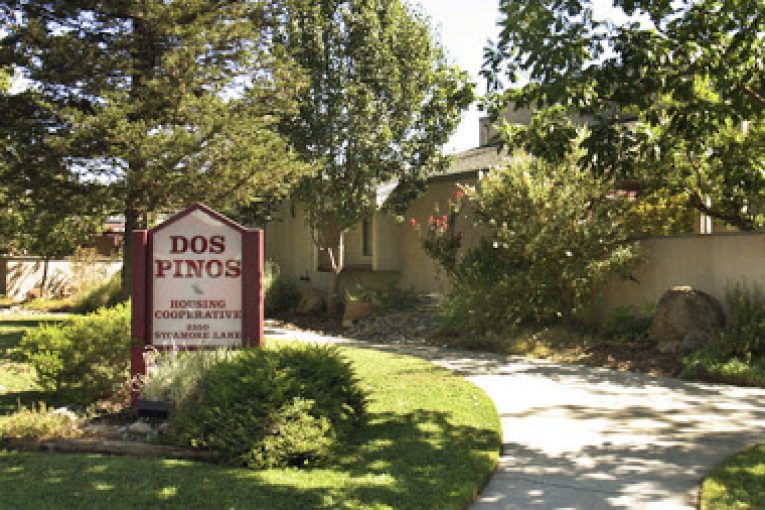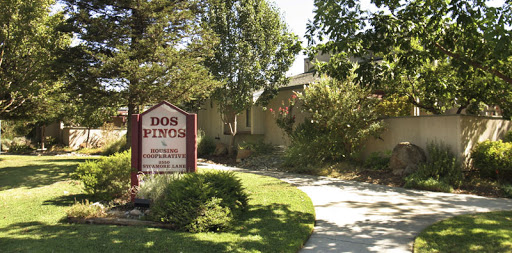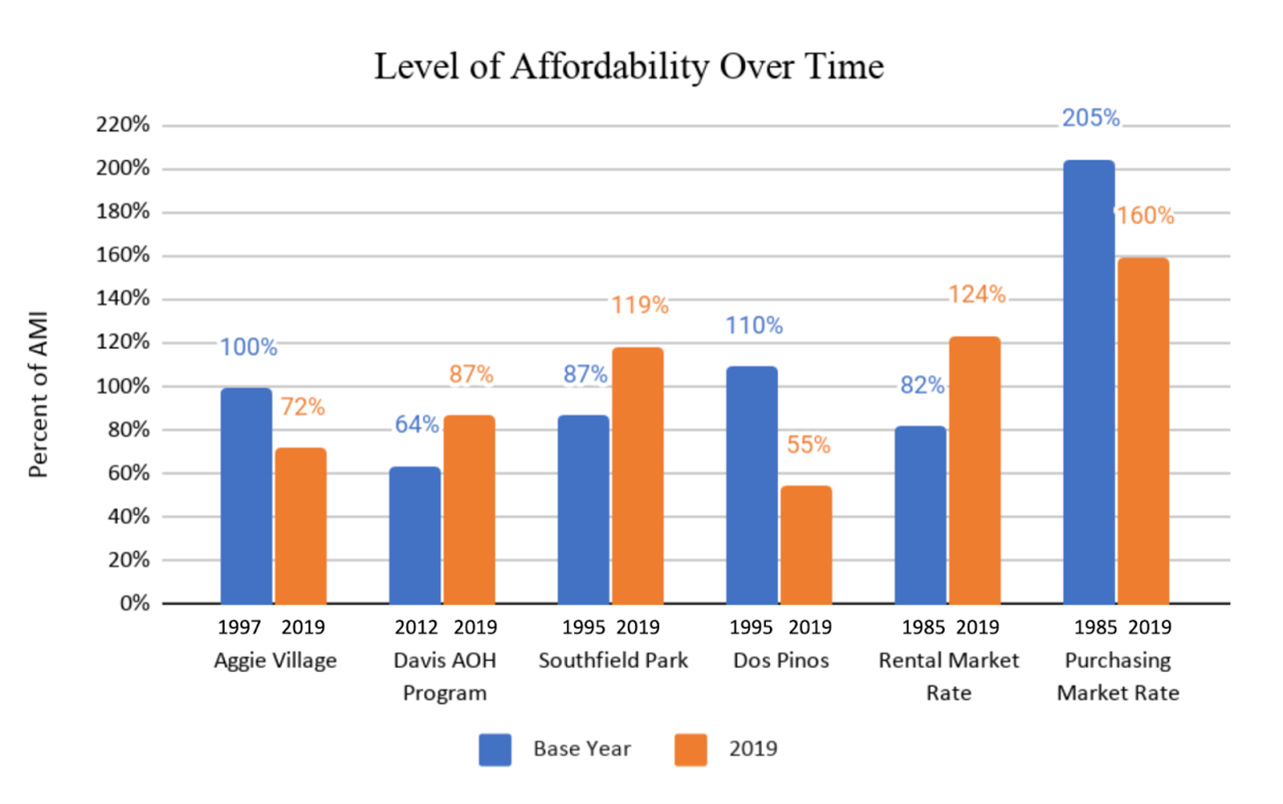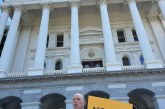

The Dos Pinos Success Story
by David J. Thompson
In 1981, I was approached by John Hammond, local architect, and Bob Black (then a County Supervisor). Their partnership had taken an option on an undeveloped site in North Davis along Sycamore Drive called Senda Nueva. They wanted me to finance a Limited Equity Housing Cooperative (LEHC) on the site (later called Dos Pinos). At the time I was the Western Regional Director of the National Consumer Cooperative Bank and living in Davis with my wife Ann Evans.
Later, Karen and Lou Fox of Sweetwater Development took over the option and asked me to continue my efforts. In that era, the City of Davis had an allocation system which allowed for a certain number of new housing units to be added to the city per year. Local developers then came forward with their plans and the City decided which ones to approve. The Foxes believed as did Hammond and Black that including a 60-unit permanently affordable housing co-op would be an attractive feature of their application. It would be the first affordable housing in Davis included in a sub-division application. The centerpiece of their Senda Nueva plan would be the Marketplace Shopping Center on Covell next to Highway 113.
The regulatory path was opened when the Foxes asked the Davis City Council to pass an ordinance that owing to its permanent affordability, 120-units of limited equity housing cooperative would be exempted from the allocation process. The maximum number of units that could be built on the Senda Nueva site was 41 units. However, as an additional encouragement to bring the overall costs down and to create more affordable units, the City allowed 60 units to be built. The final density was 15-units-per-acre on the four-acre site. The Senda Nueva sub-division was then approved partially owing to its having the first inclusionary affordable housing community in the City of Davis.
From then on, the City required all major housing applications to include a specific number of units of affordable housing according to the size of the project’s housing mix of single family and multi-family units. The inclusionary requirements changed over time. At the moment the interim requirement is 15%.
In 1983, the Senda Nueva sub-division was approved. After that, I was asked by the Foxes to do a series of educational workshops on a LEHC. We held these in the room above the Sweetwater offices on D Street. Seventy-five people (most of them young couples) eagerly attended the first workshop.
Just as it is today in 2023, there were almost no opportunities for young, moderate- income families to get homeownership in Davis. Dos Pinos was seen by many families as a better deal than renting. After having written many articles about the cost of housing in Davis followed by writing articles about Dos Pinos as a new opportunity, the four senior editorial staff of the Davis Enterprise all joined and moved into Dos Pinos.
The “Groundbreaking Ceremony” took place on January 30, 1985, and by November that same year, the first members had moved in. In December 1985, Mayor Ann Evans led the “Grand Opening Ceremony.” By March 1986, all 60 co-op apartments were occupied and 60 Davis families had moved out of rentals into homeownership.
The Foxes built the 60-unit Dos Pinos development using the architecture and passive-solar design of Jon Hammond. Included were a community room, swimming pool, laundry room, and manager’s office and community gardens.
Part of the Davis greenbelt borders the north end of the site which converts into a thickly treed gulley which goes through to Sycamore. As they had promised, the National Consumer Cooperative Bank funded the long-term mortgage. Dos Pinos was the first LEHC not subsidized by government funding.

**Down Payment required for that size unit (no real estate costs)
The Monthly Charge covers everything except the gas and electric bill for the unit.
The Monthly Charge includes: loan payment, reserves, fire and liability insurance, water/sewer/garbage, DP management and accounting, corporate fees, licenses and taxes, maintenance (grounds and buildings) and Senda Nueva Homeowners fees.
https://dospinosdavis.org/
Below is a graph on the comparison of affordability over time of Dos Pinos and three other affordable ownership housing versus market rate rental and home ownership in Davis. Of the four programs, Dos Pinos has the best long term results.

Graph extracted from MODELS OF WORKFORCE AFFORDABLE OWNERSHIP HOUSING OVER TIME. By Mikaela Fenton, Signature Work, UHP Project, submitted for completion of University Honors Program, UC Davis, June, 11, 2020
An article about affordable housing in Davis by David J. Thompson. David has been developing affordable housing in Davis since Dos Pinos in 1983. These are the thoughts of the author and are not representative of Dos Pinos, Twin Pines Cooperative Foundation or Neighborhood Partners, LLC.






Great to know the history of this project. It’s pretty amazing that the affordable component remained more or less intact given the massive changes to Senda Nueva from the time Hammond proposed it to the time it finally got built by other developers. Most people are unaware that the whole project originally was designed to be much like Village Homes. Some of the objections and changes will likely sound familiar….
From Mike Fitch’es book Growing Pains, available at the city website:
Interesting read
In those days there was no acute housing shortage or climate crisis. You could afford to take the time to evolve a housing proposal to achieve the best outcome. People should pay no attention to the falsehoods coming from a former commenter regarding our housing crisis. He is perpetrating one of the biggest scams in California history. There is a severe lack of housing in all counties in our State. To claim otherwise is a lie. He is nothing more than a narrow minded obstructionist.
Thanks Don for bringing Mike Fitch’s reference to the blog.
As an Enterprise journalist, Mike Fitch had been covering the totality of housing and housing affordability issues for a number of years. In writing about Dos Pinos as an affordable housing opportunity, Fitch attended the various public meetings. His writings spoke of the values of Dos Pinos versus renting in town. By the time that Dos Pinos became available four editors at the Enterprise were living there; Jeff Averbach, Debbie Davis, Bruce Gallaudet and of course Mike Fitch.
Jeff Averbach served on the original board of directors.
Given the successful economic and social outcomes of Dos Pinos I am pleased that it has turned out even better than I had expected. Market rate rents keep going up faster tha income in Davis.
If you moved out of the average three bedrooom rental in Davis to Dos Pinos your family would save close to $14,000 a year in real dollars.
Most Davis renters overpay (pay more than the HUD guidelines) rent but not at Dos Pinos.
So given how Dos Pinos helps a Davis family why is there only one Dos Pinos in Davis?
Why do the four applicants not include a Dos Pinos in their plans?